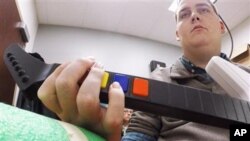Doctors have given a paralyzed man some use of his right hand using a computer and electronic sensors.
As a result, Ian Burkhart, 24, can perform simple tasks like holding a bottle, pouring the contents out, picking up a stick and stirring. He can also swipe a credit card, move individual fingers and even hold a toothbrush, according to the Associated Press.
He can even play the popular video game, Guitar Hero.
But so far those activities have been confined to a laboratory setting, and Burkhart is only able to perform the tasks for a few hours over the course of aweek because he must stay hooked up to a device that “interprets his brain signals and stimulates his muscles with electrodes on his forearm,” the AP reported.
"This is taking one's thoughts and, within milliseconds, linking it to concrete movements," said Dr. Ali Rezai, who is a neurosurgeon at Ohio State University, and the author of a study on Burkhart.
The system works through a cable that is attached to a “small projection from his skull.” This carries signals to a computer focused on trying to interpret the task Burkhart is trying to accomplish.
From the computer, commands are sent to as many as 160 electrodes on his forearm. Those electrodes stimulate his hand and finger muscles.
Burkhart was injured at the age of 19 when he dove head-first into water he thought was deep, hitting his hand on a sandbar and breaking his neck. After the injury, he was unable to move below the shoulders.
Doctors told him he’d never walk or be able to use his hands again.
But Burkhart was more optimistic.
"I had a feeling after my accident that there would be some improvements in science, technology, and medicine that would improve my quality of life," Burkhart told the website Gizmodo. "I've always been a big fan of technology, and because I was getting therapy at Ohio State, I knew about the kind of work being done there. I just made my interest known, and once the researchers got to a point where they were looking for a test subject, they contacted me. Luckily, I was able to check off all the boxes listing the requirements they were looking for."
Turns out his optimism paid off.
"The first time moving my hand — that was really just like that flicker of hope," Burkhart told reporters during a media briefing Tuesday.
According to the AP, Burkhart feels a tingle in his arm, but added that his muscles get tired quickly. Additionally, he said practicing using the device was mentally taxing, but that is has "gotten much easier."
When learning a new task, Burkhart says"I kind of have to think about it a little bit beforehand, and really think through what I'm trying to accomplish."
Burkhart’s story could give hope to others with spinal cord injuries, and researchers say that future iterations of the device might be untethered, allowing more freedom.










